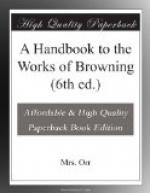“CENCIAJA” signifies matter relating to the “Cenci;"[84] and the poem describes an incident extraneous to the “Cenci” tragedy, but which strongly influenced its course. This incident was the murder of the widowed Marchesa dell’ Oriolo, by her younger son, Paolo Santa Croce, who thus avenged her refusal to invest him with his elder brother’s rights. He escaped the hands of justice, though only to perish in some other disastrous way. But the matricide had been committed on the very day which closed the trial of the Cenci family for the assassination of its Head; and it sealed Beatrice’s fate. Her sentence seemed about to be remitted. The Pope now declared that she must die.
... “Paolo Santo Croce
Murdered his mother also yestereve,
And he is fled: she shall not flee at least!”
(vol. xiv. p. 104.)
The elder son of the Marchesa, Onofrio Marchese dell’ Oriolo, was arrested on the strength of an ambiguous scrap of writing, which appeared to implicate him in his brother’s guilt; and subjected in prison to such a daily and day-long examination on the subject of this letter, that his mind gave way, and the desired avowal was extracted from him. He confessed to having implied, under reserves and conditions which practically neutralized the confession, his assent to his mother’s death. He was beheaded accordingly; and the Governor of Rome, Taverna, who had conducted the inquisition, was rewarded by a Cardinal’s hat. Other motives were, however, involved in the proceeding than the Pope’s quickened zeal for justice. He had entrusted the case to his nephew, Cardinal Aldobrandini; and it was known that the Cardinal and the Marchese had courted the same lady, and the latter unwisely flaunted the possession of a ring which was his pledge of victory.
This story, with other details which I have not space to give, was taken from a contemporary Italian chronicle, of which some lines are literally transcribed.
The heretic of “THE HERETIC’S TRAGEDY” was Jacques du Bourg-Molay, last Grand Master of the Order of Knights Templars, and against whom preposterous accusations had been brought. This “Jacques,” whom the speaker erroneously calls “John,” and who might stand for any victim of middle-age fanaticism, was burned in Paris in 1314; and the “Interlude,” we are told, “would seem to be a reminiscence of this event, as distorted by two centuries of refraction from Flemish brain to brain.” The scene is carried on by one singer, in a succession of verses, and by a chorus which takes up the last and most significant words of each verse; the organ accompanying in a plagal cadence,[85] which completes its effect. The chant is preceded by an admonition from the abbot, which lays down its text: that God is unchanging, and His justice as infinite as His mercy; and singer and chorus both denounce the impious heresy of “John:” who admitted only the love, and sinned the “Unknown Sin,” in his confidence in it. How the logs are fired; how the victim roasts; amidst what hideous and fantastic torments the damned soul “flares forth into the dark” is quaintly and powerfully described.




